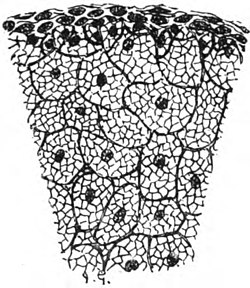Sebaceous Glands
These are holocrine glands – sebum is produced by cell breakdown. It is located in the upper half of the coria, opens into the infundibula of the hair follicles (but also without hair), together with it forms the so-called pilosebaceous unit. They are characterized by seborrheic localization - i.e., the face (nose and surroundings), upper parts of the breasts and back, on the contrary, they are not on the palms and soles. These also include Meibomian Glands and the praeputiales Tysoni. Their secretion is influenced by hormones (predominantly androgens).
Sebum is an oily secretion that is formed from dead epithelial cells. Active basal cells are located in the periphery of the lobule. Towards the inside, they differentiate and contain a greater number of fat droplets. Their nucleus disintegrates, cells die and turn into secretions. Per day, the glands secrete 2 grams of sebum. On the whole body we have from 100 to 300 thousand sebaceous glands.
Links[edit | edit source]
Related Articles[edit | edit source]
- Cutaneous adnexa
- Nails
- Apocrine glands
- Eccrine sweat glands
- Hair and hair
- Anatomy of the skin
- Skin physiology
- Histology: Thick skin (histological preparation) | Axilla/histology slide
Source[edit | edit source]
- BENES, Jiří. Study materials [online]. ©2007. [cit. 30.11.2010]. <http://jirben2.chytrak.cz/>.
Bibliography[edit | edit source]
- ŠTORK, Jiří, et al. Dermatovenereology. 1. edition. Prague : Galén, Karolinum, 2008. ISBN 978-80-7262-371-6.
- LÜLLMANN-RAUCH, Renate. Histology. 3. edition. Grada Publishing a.s., 2012. 556 pp. ISBN 9788024737294.


